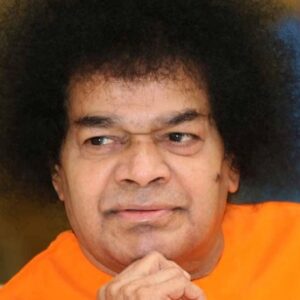Sathya Sai Baba was an Indian teacher who claimed to be Sai Baba of Shirdi’s reincarnation. He was both a famous and a controversial character, known for performing’miracles’ such as the materialization of holy ash and minor objects, resurrections, clairvoyance, and miraculous healings. He had a large number of enthusiastic admirers who looked up to him as a great religious guru, as well as adversaries who accused him of being a scam. Nonetheless, he was a great religious figure in India, and the Sathya Sai Organization, which he created, is still active today, with over 1,200 Sathya Sai Centres (branches) in 126 countries. He was born into a religious household in British India, and it is said that miracles foretold his birth. According to certain stories, his conception was miraculous. He grew up to be a bright and compassionate young man who revealed to his family at the age of 14 that he was the reincarnation of Sai Baba of Shirdi, a famous Indian saint who had died eight years before Sathya was born. He became a spiritual teacher and formed the Sri Sathya Sai Organization to “allow its followers to engage in volunteer activities as a means of spiritual progress.”
Childhood and Adolescence
On November 23, 1926, in Puttaparthi, Madras Presidency (now Andhra Pradesh), British India, he was born as Sathyanarayana Raju. Meesaraganda Easwaramma and Peddavenkama Raju Ratnakaram were his parents. Sathya was born miraculously, according to his mother, who said that an unusual bluish glow changed into a brilliant ball and entered her womb at the village well, resulting in her pregnancy. Sathya was one of four children.
He grew up to be a bright young man with extraordinary abilities in religious music, dance, and theatre. He had always been more drawn to spirituality than to worldly pursuits since he was a child.
When Sathya was 14, she experienced a life-changing event. He was presumably stung by a scorpion on March 8, 1940, and lost consciousness for several hours. Over the next few days, he began to act abnormally, and doctors diagnosed him with hysteria. His worried parents sought the advice of a number of priests, doctors, and exorcists, but none of them were able to “heal” him of this ostensibly bizarre ailment.
On May 23, 1940, Sathya created ‘prasad’ and flowers out of thin air, stunning his parents even further. Then, on October 20 of the same year, he declared himself to be the reincarnation of Shirdi’s Sai Baba, a well-known saint who had died eight years before Sathya was born.
In addition, Sathya Sai Baba stated that his goal was to teach humanity the values of truth, good conduct, peace, and divine love in order to help them evolve spiritually.
Later in life, Sathya Sai Baba began to communicate heavenly wisdom to the general public, and he quickly established a loyal following. To accommodate the expanding number of Sai Baba devotees, a temple was built near the village of Puttaparthi in 1944.
He began supervising the construction of Prashanthi Nilayam, which would eventually become his main ashram, in 1948. The principal engineer and architect, Sathya Sai Baba, was in charge of the entire project’s construction. On November 23, 1950, his 24th birthday, the ashram was inaugurated.
He became well-known over time for his amazing healing abilities and philanthropic endeavors. In 1954, he constructed a tiny free general hospital for the destitute in the village of Puttaparthi.
In the 1960s, he established The Sri Sathya Sai Organization “to enable its followers to engage in volunteer activities as a means of spiritual progress.” In India, the first Sai Centres were established under the name of the “”Sri Sathya Sai Seva Samithi,” or “Sri Sathya Sai Seva Samithi,”
In India, he founded three main mandirs or spiritual centers: “Dharmakshetra” or “Sathyam.” “”Shivam” was released in Hyderabad in 1973, and “Sundaram” was released in Chennai in 1981.
In 1981, Sathya Sai Baba established the Sri Sathya Sai University. The university has three campuses: Ananthapur (for women), Prasanthi Nilayam (for men), and Brindavan (for everyone) (for men, on the outskirts of Bangalore).
He founded a network of free hospitals, including the Sri Sathya Sai General Hospital in Bangalore, which offers free difficult surgery, food, and medicine. He also founded a number of general hospitals, two specialized hospitals, eye hospitals, and mobile dispensaries. His foundation also organizes medical camps in India’s rural and slum areas.
Despite all of his philanthropic and spiritual endeavors, he was a divisive figure. Sleight of hand, sexual assault, money laundering, fraud in the conduct of service projects, and murder were among the charges leveled against him. He and his supporters, on the other hand, categorically denied any charges of impropriety, claiming that his critics were attempting to discredit him.
Major Projects of Sai Baba
In the 1960s, Sathya Sai Baba launched the Sri Sathya Sai Organization, which developed multiple hospitals, educational institutes, ashrams, and drinking water delivery projects. Even years after his death, the organization has over 1,200 Sathya Sai Centres (branches) in 126 countries and continues to serve humanity.
Personal History and Legacy
In a rare accident in 2003, he shattered his hip and began using a wheelchair in 2004. During his senior years, he made fewer public appearances.
After nearly a month in the hospital for respiratory difficulties, Sathya Sai Baba died on April 24, 2011. On April 27, 2011, he was buried with full state honors in front of a crowd that included former Indian Prime Minister Manmohan Singh, Gujarat Chief Minister Narendra Modi, cricketer Sachin Tendulkar, and others.
Estimated Net Worth
Sathya Sai Baba established a huge number of schools, colleges, hospitals, and other charity organizations in India and overseas, with a net financial capital of 400 billion rupees (US$9 billion). However, estimations as high as 1.4 trillion dollars (about $31.5 billion) have been suggested.


